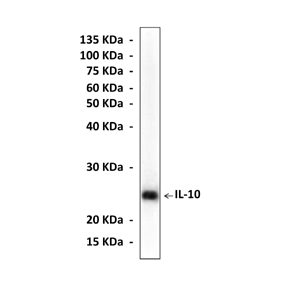Product Sheet CP10327
Description
BACKGROUND Interleukin-10 (IL-10) is a pleiotropic cytokine produced by monocytes/macrophages, B cells, and various subsets of T cells including T helper type 2 (Th2), Th0 cells, and regulatory T (Treg) cells, to a lesser extent by Th1 cells, dendritic cells, mast cells and various tumor cell lines. Its main biological functions seem to limit and terminate the inflammatory responses, block the proinflammatory cytokine secretion and regulate the differentiation and proliferation of several immune competent cells such as T cells, B cells, natural killer cells, antigen-presenting cells, mast cells, and granulocytes. It plays important immunosuppressive and anti-inflammatory role in nature and therefore, it has been exploited therapeutically for the treatment of various autoimmune disorders such as inflammatory bowel disease, psoriasis and rheumatoid arthritis. Overall, the results suggest that in infectious diseases wherein inflammation constitutes a critical component of pathogenesis, IL-10 appears to be playing a beneficial role by limiting the extent of inflammation.1 However, many studies suggest IL-10 also mediates immunostimulatory properties that help to eliminate infectious and noninfectious particles with limited inflammation. It has been shown that both human IL-10 and murine IL-10 exert immunostimulatory effects by up-regulating MHC class II expression on B lymphocytes, and inducing cytotoxic T-cell differentiation. These very different outcomes are believed to depend upon experimental conditions; the dominant immune effector mediating a given immune response, the timing of IL-10 production/ administration, and IL-10 dose and/or location of expression.2 In addition, IL-10 overexpression was found in certain tumors such as melanoma and several lymphomas and is considered to promote further tumor development. In contrast, a relative IL-10 deficiency has been observed and is regarded to be of pathophysiological relevance in certain inflammatory disorders characterized by a type 1 cytokine pattern such as psoriasis.3 However, systemic IL-10 release is a powerful tool of the central nervous system to prevent hyperinflammatory processes by activation of the neuro-endocrine axis following acute stress reactions.4
Human IL-10 binds as a 2-fold symmetric homodimer to a functional tetrameric complex of two receptors, consisting of two a- or R1 chains which bind to IL-10, and of two CRF2-4 chains (b- or R2) which initiate the IL-10-induced signal transduction events. CRF2-4 is a member of the class II cytokine receptor family (CRF2), which includes the IFN receptors and is encoded by the CRFB4 gene on chromosome 21. IL-10R generates its signals through the JAK1-STAT3 pathway and activates the SOCS-3 gene (suppressor of cytokine signalling-3) of which the expression results in inhibition of JAK/STAT-dependent signaling and the expression of many genes in the cells. Some of the actions of IL-10 can be explained by an inhibitory effect on the transcription factor nuclear factor-kB (NF-kB), but this does not account for all effects as IL-10 is very effective on inhibiting IL-5 transcription which is independent of NF-kB.5
Human IL-10 binds as a 2-fold symmetric homodimer to a functional tetrameric complex of two receptors, consisting of two a- or R1 chains which bind to IL-10, and of two CRF2-4 chains (b- or R2) which initiate the IL-10-induced signal transduction events. CRF2-4 is a member of the class II cytokine receptor family (CRF2), which includes the IFN receptors and is encoded by the CRFB4 gene on chromosome 21. IL-10R generates its signals through the JAK1-STAT3 pathway and activates the SOCS-3 gene (suppressor of cytokine signalling-3) of which the expression results in inhibition of JAK/STAT-dependent signaling and the expression of many genes in the cells. Some of the actions of IL-10 can be explained by an inhibitory effect on the transcription factor nuclear factor-kB (NF-kB), but this does not account for all effects as IL-10 is very effective on inhibiting IL-5 transcription which is independent of NF-kB.5
REFERENCES
1. Couper, K.N. et al: J. Immunol. 180:5771-7, 2008
2. Asadullah, K. et al: Pharmacol. Rev. 55:241–69, 2003
3. Asadullah, K. et al: Expert Opin. Investig. Drugs 9:95-102, 2000
4. Platzer, C. et al: J. Neuroimmunol. 105:31-8, 2000
5. Riley, J.K. et al: J. Biol. Chem. 274:16513-21, 1999
2. Asadullah, K. et al: Pharmacol. Rev. 55:241–69, 2003
3. Asadullah, K. et al: Expert Opin. Investig. Drugs 9:95-102, 2000
4. Platzer, C. et al: J. Neuroimmunol. 105:31-8, 2000
5. Riley, J.K. et al: J. Biol. Chem. 274:16513-21, 1999
Products are for research use only. They are not intended for human, animal, or diagnostic applications.
Details
Cat.No.: | CP10327 |
Antigen: | Raised against recombinant human IL-10 fragments expressed in E. coli. |
Isotype: | Mouse IgG1 |
Species & predicted species cross- reactivity ( ): | Human, Mouse, Rat |
Applications & Suggested starting dilutions:* | WB 1:1000 IP 1:50 IHC n/d ICC n/d FACS n/d |
Predicted Molecular Weight of protein: | 24 kDa |
Specificity/Sensitivity: | Detects endogenous IL-10 proteins without cross-reactivity with other family members. |
Storage: | Store at -20°C, 4°C for frequent use. Avoid repeated freeze-thaw cycles. |
*Optimal working dilutions must be determined by end user.
Products
| Product | Size | CAT.# | Price | Quantity |
|---|---|---|---|---|
| Mouse Interleukin-10 Antibody: Mouse Interleukin-10 Antibody | Size: 100 ul | CAT.#: CP10327 | Price: $295.00 |

